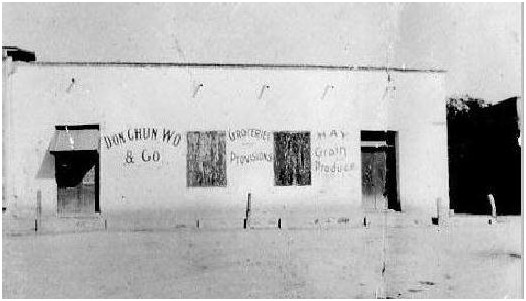
Tucson's Chinatowns
USINFO | 2013-08-05 15:33

Many of the earliest Chinese immigrants living in Tucson moved into run-down adobe buildings located at the west end of Pennington Street. The residents of "Old Chinatown" were primarily young men trying to become established in this country. Wash houses, stores and opium dens soon sprang up in the area. [Henry, E-3] The Chinese population eventually spread southward, and by 1908, 37 Chinese businesses were operating south of Congress Street. Many Chinese families moved with their businesses, settling in neighborhoods alongside Anglo and Hispanic families.
New construction gradually swallowed up Old Chinatown. In 1911, a block of buildings west of Main between Pennington and Alameda streets was demolished to make way for a Women's Club. Additional buildings were lost to make way for City Hall and new, costly homes being built along Paseo Redondo.
A second "Chinatown" evolved in the area roughly bordered by Meyer, Main, McCormick and Broadway. Eventually Ying On, a Chinese association, grew large enough to own the city block bounded by Meyer, Main, Jackson and Broadway. Chinese associations played a role in helping immigrants get established. Many associations were based on family relationships. Ying On was a non-family group that became the largest and most influential in Tucson.
Ying On owned a large, gray building on Main Street between Broadway and Ochoa where it rented rooms to single Chinese men and provided a place for the Chinese community to meet and socialize. This building had been originally built by Leopoldo Carrillo in 1898. It is described in a 1937 Arizona Daily Star feature as,
While not exactly a rabbit warren, it approximates one in some respects and is the last stronghold of the old China in Tucson. The furnishings are old and worn, the great community cook stoves and ovens built up on brick bases under the overhanging roof of the patio are older than the building itself.
Chinese proclamations on sundry inscrutable subjects adorn the inside walls. Laundry hangs from wires stretched from corner to corner. This old Carrillo building, put up by a Mexican, has lost all its Spanish-American attributes, and is now wholly Oriental.
In later years, this building also was a place where many old men returned to live out the remainder of their lives. After death, their room would be sealed up, leaving their clothing, dishes, and other belongings just as they were. [Turner p.4]
This building would act as a focal point for the Chinese community for nearly 31 years, until the entire eight block area was demolished in the 1960's prior to building the Convention Center.
Other buildings that were focal points for the Chinese-American community were institutions like the Chinese Mission School, located on Ott Street in the late 1890's, and the Chinese Evangelical Church on Meyer Street.
By the 1920's many of the younger Chinese were active in the mainstream society, including political parties and business associations. To maintain ties to their native land and to nurture cultural identity, the Chinese Evangelical Church brought a minister from China in 1930. He was hired to conduct Chinese church services and to teach the children Chinese.
New construction gradually swallowed up Old Chinatown. In 1911, a block of buildings west of Main between Pennington and Alameda streets was demolished to make way for a Women's Club. Additional buildings were lost to make way for City Hall and new, costly homes being built along Paseo Redondo.
A second "Chinatown" evolved in the area roughly bordered by Meyer, Main, McCormick and Broadway. Eventually Ying On, a Chinese association, grew large enough to own the city block bounded by Meyer, Main, Jackson and Broadway. Chinese associations played a role in helping immigrants get established. Many associations were based on family relationships. Ying On was a non-family group that became the largest and most influential in Tucson.
Ying On owned a large, gray building on Main Street between Broadway and Ochoa where it rented rooms to single Chinese men and provided a place for the Chinese community to meet and socialize. This building had been originally built by Leopoldo Carrillo in 1898. It is described in a 1937 Arizona Daily Star feature as,
While not exactly a rabbit warren, it approximates one in some respects and is the last stronghold of the old China in Tucson. The furnishings are old and worn, the great community cook stoves and ovens built up on brick bases under the overhanging roof of the patio are older than the building itself.
Chinese proclamations on sundry inscrutable subjects adorn the inside walls. Laundry hangs from wires stretched from corner to corner. This old Carrillo building, put up by a Mexican, has lost all its Spanish-American attributes, and is now wholly Oriental.
In later years, this building also was a place where many old men returned to live out the remainder of their lives. After death, their room would be sealed up, leaving their clothing, dishes, and other belongings just as they were. [Turner p.4]
This building would act as a focal point for the Chinese community for nearly 31 years, until the entire eight block area was demolished in the 1960's prior to building the Convention Center.
Other buildings that were focal points for the Chinese-American community were institutions like the Chinese Mission School, located on Ott Street in the late 1890's, and the Chinese Evangelical Church on Meyer Street.
By the 1920's many of the younger Chinese were active in the mainstream society, including political parties and business associations. To maintain ties to their native land and to nurture cultural identity, the Chinese Evangelical Church brought a minister from China in 1930. He was hired to conduct Chinese church services and to teach the children Chinese.
Share this page



















